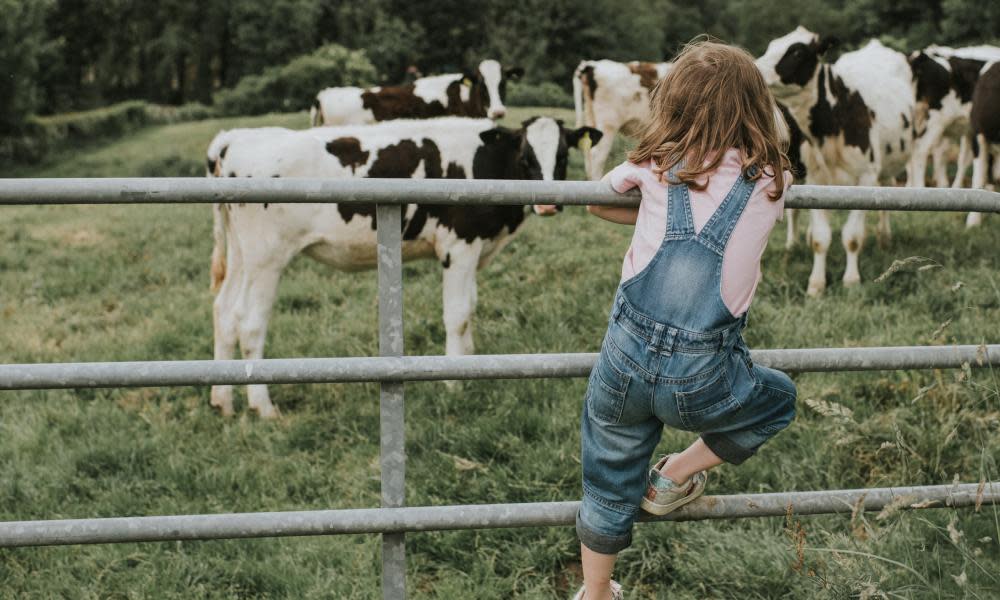Amy & Lan by Sadie Jones review – larks and losses on a rural commune

Amy Connell and Lachlan Honey are childhood soulmates on a Herefordshire smallholding, closer even than siblings, born just a few days apart. They celebrate their birthdays every summer solstice with a ramshackle picnic on a nearby hill, surrounded by sweaty adults and grubby children. The grownups bring cake and red wine and homemade elderflower champagne. They also drag up a greased wheelie bin full of rats, which have been caught on the farm and need to be released in the wild. The rats squeak and scratch. They make the wheelie bin shake. “I bet they’re eating each other,” sniffs one of the kids. “Or having sex.”
Throw too many creatures together, one fears, and sooner or later they’ll devour each other or start having sex. It’s a harsh law of nature, as immutable as the seasons and as applicable to hippies on the Welsh borders as it is to rodents in a bin. Amy and Lan love living on Frith Farm, scything and baling and naming all the goats. But the idyll can’t last, the weather turns chilly – and that squeaking and scratching grows more persistent by the month.
Sadie Jones’s sixth novel is a fabulous thing: vivid and funny, sometimes heart-rendingly sad. Like Frith, it positions itself as a retreat from the big bad modern world, a deliberate step-change after 2019’s moneyed state-of-Europe bestseller The Snakes. But again, like the farm, the setup is misleading. Jones’s fictional landscape is jam-packed, abundant, and her smallholding as thick with intrigue as the Borgias’ court.
The happiest childhoods, perhaps, are lived in a spirit of ruthless innocence
Surfing a wave of children’s chatter, the book traces the commune’s history and gently exposes its faultlines. It introduces us to Lan’s feckless mum and peacekeeping stepdad. It circles Amy’s father, Adam, a resting actor who once played “Angry Restaurateur” in an episode of Casualty. Finally, it casts its net wide to include a bulging gallery of supporting players. We meet the dreamers and misfits folded in cheek by jowl; the handymen and farmers the kids know only by their nicknames (Boring Colin, Racist Rick, the Bony-Eyes-Flatbed-Trailer-Man). When Amy and Lan watch the TV news, they conclude that the outside world is brown and ugly, nothing like Frith at all. Everything good is right here on their doorstep.
Jones does a fine job of painting this dysfunctional utopia, held together with chicken wire and petty cash. But her novel works best as a kind of conjoined coming-of-age tale, flicking between Amy and Lan’s narration as they march from early childhood towards puberty. Their lives are a fog of merry confusions and crossed wires. They’re so giddy on bonfires and kittens that their senses are scrambled. So they explain that they’re not allowed to eat ketchup “because of sugar or money” and insist that the farm’s hermit has polio when he’s been diagnosed as bipolar. Young Amy knows her mum’s birthday but that’s about as far as it goes. Idly, she says, “She’s 37, I think, or 67.”
Frith appears ageless, unchanging. But, of course, that’s a lie. The world knocks at the door. Simmering tensions break cover. After Adam converts the old barn into a holiday let, the ground is laid for the tale’s comic-horror centrepiece in which a rich London couple arrive at Frith with their son. Toby, who’s seven, worries that ants might be poisonous and claims that touching sheep makes you blind. When the boy goes missing during a game of hide and seek, the decision is taken to alert his mum and dad. Amy observes their reaction with owl-eyed fascination. She reports: “The Guest Parents switch from happy to completely out of control.”
Jones’s tale, for its part, has a similarly precarious air. The prose skips freely between the past and present tense. Amy and Lan’s voices are interchangeable, overlapping, like a vibrant Venn diagram, because they mostly see the world in the same way. But the book’s imperfections are all of a piece. I don’t think I’ve read another recent novel that better captures the pure sugar-rush of childhood; the sense of a life so exhilarating and ecstatic that it is almost too much to bear. There are cakes and champagne and that wheelie bin full of rats. Inevitably, too, there’ll be a flood of tears before bedtime.
Read between the lines of Jones’s prose and you can guess where we’re heading. The clues have been placed; the lid’s about to come loose. It’s tempting, then, to file Amy & Lan alongside the likes of What Maisie Knew and The Go-Between, part of a subgenre of detective fiction that trains a guileless child’s eye on a world of adult foibles and invites the reader to join the dots. Except that this doesn’t quite wash. The truth is more complicated than that. The happiest childhoods, perhaps, are lived in a spirit of ruthless innocence. Kids see what they like and gloss over the rest, figuring that it’s inconsequential, un-fun, almost a waste of breath to describe. And so it is with Amy and Lan, the sun children of Frith, who know an awful lot more than they choose to admit. They like kittens and goats and mucking about on the roof. They love their cow, Gabriella, and her calf, Angel Rocket. Parental dramas don’t matter until the very moment they do: when they break in, brown and ugly, and burn paradise to the ground.
• Amy & Lan is published by Chatto & Windus (£16.99). To support the Guardian and Observer, order your copy at guardianbookshop.com. Delivery charges may apply.

 Yahoo Movies
Yahoo Movies 
